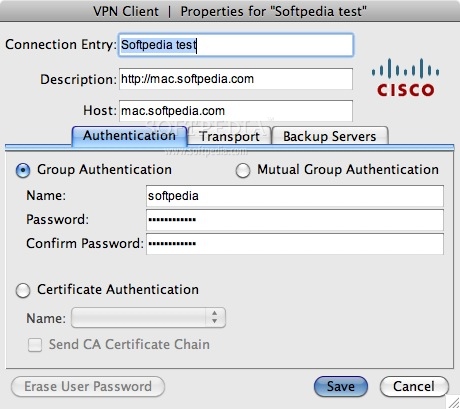Vpn Clients For Mac
Initial configurations (only once at the first time) Click the network icon on the top-right side on the Mac screen. Click 'Open Network Preferences.' Click the '+' button on the network configuration screen. Select 'VPN' as 'Interface', 'L2TP over IPsec' as 'VPN Type' and click the 'Create' button. A new L2TP VPN configuration will be created, and the configuration screen will appear.

On this screen, you have to specify either hostname or IP address of the destination SoftEther VPN Server. After you specified the 'Server Address', input the user-name on the 'Account Name' field, which is the next to the 'Server Address' field. Next, click the 'Authentication Settings.' The authentication screen will appear. Input your password in the 'Password' field. Specify the pre-shared key also on the 'Shared Secret' field.
After you input them, click the 'OK' button. After return to the previous screen, check the 'Show VPN status in menu bar' and click the 'Advanced.' The advanced settings will be appeared.
Check the 'Send all traffic over VPN connection' and click the 'OK' button. On the VPN connection settings screen, click the 'Connect' button to start the VPN connection.
Cisco AnyConnect is the recommended VPN client for Mac. The is another option but is more likely to suffer from disconnects. Overview Stanford's VPN allows you to connect to Stanford's network as if you were on campus, making access to restricted services possible. To connect to the VPN from your Mac you need to install the Cisco AnyConnect VPN client. Two types of VPN are available:. Default Stanford (split-tunnel).
Open Vpn Clients For Mac
When using Stanford's VPN from home, we generally recommend using the Default Stanford split-tunnel VPN. This routes and encrypts all traffic going to Stanford sites and systems through the Stanford network as if you were on campus. All non-Stanford traffic proceeds to its destination directly.
Full Traffic (non-split-tunnel). This encrypts all internet traffic from your computer but may inadvertently block you from using resources on your local network, such as a networked printer at home. If you are traveling or using wi-fi in an untrusted location like a coffee shop or hotel, you may wish to encrypt all of your internet traffic through the Full Traffic non-split-tunnel VPN to provide an additional layer of security.
You can select the type of VPN you want to use each time you connect. Install the VPN client.
Double-click the InstallAnyConnect.pkg file to start the Cisco AnyConnect Installer wizard. When the Welcome window displays, click Continue. Select your hard drive as the destination where you want to install Cisco AnyConnect and then click Continue. Click Install to perform a standard installation of the software.
Robots for machine tools. How to install ROBOTC on a MAC. ROBOTC will work on a Mac with any of the Windows Virtualization/Emulation software packages that are available, example. VEX Robotics Support. Use the resources below to get help with the VEX CORTEX & VEX IQ. « Back to Contact / Submit Ticket. Installing more than one version.
At the prompt, enter your administrator account password for the Mac and click Install Software. When the software has finished installing, click Close. Connect to the Stanford VPN. To launch the VPN client, open your Applications folder and navigate to Cisco Cisco AnyConnect Secure Mobility Client.app. When prompted for a VPN, enter su-vpn.stanford.edu and then click Connect.

Enter the following information and then click OK:. Group: select Default Stanford split- tunnel (non-Stanford traffic flows normally on an unencrypted internet connection) or Full Traffic non-split-tunnel (all internet traffic flows through the VPN connection). Username: your SUNet ID. Password: your SUNet ID password. Next, the prompt for two-step authentication displays.
Enter a passcode or enter the number that corresponds to another option (in this example, enter 1 to authenticate using Duo Push on an iPad). You may have to scroll down the list to see all of your options. Then click Continue. If your only registered authentication method is printed list, hardware token, or Google Authenticator, the menu does not display. Enter a passcode in the Answer field and click Continue. Click Accept to connect to the Stanford Public VPN service.

Once the VPN connection is established, the Cisco AnyConnect icon with a small lock appears in the dock. Disconnect from the Stanford VPN. Click the Cisco AnyConnect icon with a small lock. At the prompt, click Disconnect.